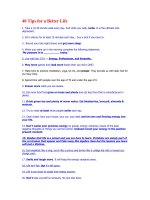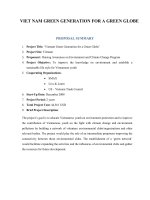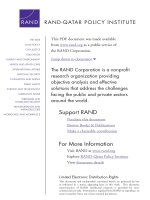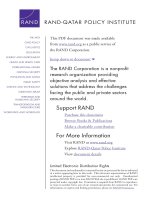HEALTH PROFESSIONALS FOR A NEW CENTURY pdf
Bạn đang xem bản rút gọn của tài liệu. Xem và tải ngay bản đầy đủ của tài liệu tại đây (4.6 MB, 116 trang )
HEALTH
PROFESSIONALS
FOR A NEW
CENTURY
Transforming education to
strengthen health systems in
an interdependent world
HealtH professionals for a new century THE COMMISSION
The Commission on Education of Health Professionals for the 21st Century was
launched in January 2010 with the aim of landscaping the field, identifying
gaps and opportunities, and offering recommendations for reform a century
after the landmark Flexner Report of 1910. This independent initiative was
led by co-chairs Julio Frenk and Lincoln Chen working with a diverse group of
20 Commissioners from around the world: Zulfiqar A Bhutta, Jordan Cohen,
Nigel Crisp, Timothy Evans, Harvey Fineberg, Patricia Garcia, Richard Horton,
Ke Yang, Patrick Kelley, Barry Kistnasamy, Afaf Meleis, David Naylor,
Ariel Pablos-Mendez, Srinath Reddy, Susan Scrimshaw, Jaime Sepulveda,
David Serwadda, and Huda Zurayk. Sponsored by the Bill and Melinda Gates
Foundation, the Rockefeller Foundation, and the China Medical Board, the
co-chairs supervised the research and management teams operating out of the
China Medical Board and the Harvard School of Public Health.
HEALTH
PROFESSIONALS
FOR A NEW
CENTURY
Transforming education to
strengthen health systems in
an interdependent world
HEALTH
PROFESSIONALS
FOR A NEW
CENTURY
Transforming education to
strengthen health systems in
an interdependent world
This Commission report (Frenk J, Chen L, et al. Health professionals for a new century: transforming education to
strengthen health systems in an interdependent world. Published online at www.thelancet.com (DOI:10.1016/S0140-
6736(10)61854-5) on Nov 29, and in The Lancet Dec 4, 2010, vol 376; pp 1923–58) was published initially in The Lancet
in November 2010. It is being reproduced in expanded book form by the Commission in full recognition of the copyrights
of The Lancet.
Distributed by Harvard University Press, Cambridge MA
ISBN 978-0-674-06148-4
Editing, design, and production by Communications Development Incorporated, Washington, DC, and Peter Grundy Art
& Design, London, UK.
v
vii Foreword
ix The Commissioners
xi Research Team
xii Scientific Advisory Committee and Youth Commissioners
1 Executive summary
5 Section 1: New contexts, new challenges
15 Section 2: Major findings
51 Section 3: Reforms for a second century
61 References
69 Annex 1: About the Commission
78 Annex 2: Data, methods, and definitions of regions
86 Annex 3: Commissioned papers
87 Annex 4: Three comments
Page
number
Contents
Page
number
vi
Figures
6 1: Flexner, Welch-Rose, and Goldmark reports
7 2: Emerging challenges to health systems
10 3: Systems framework
12 4: Key components of the educational system
16 5: Three generations of reform
25 6: Density of medical schools by region
25 7: World maps resized by population (A), burden of disease (B),
densityof medical schools (C), and density of workforce (D)
29 8: New medical schools (public and private) in India (A) and Brazil (B)
38 9: Competency-based education
40 10: Models of interprofessional and transprofessional education
53 11: Vision for a new era of professional education
57 12: Recommendations for reforms and enabling actions
81 A2.1: GDP per capita and cost per graduate-physicians (n=7)
81 A2.2: GDP per capita and physician wages (n=32)
Panels
17 1: The Flexner, Rose-Welch, and Goldmark reports
19 2: Adaptation of public health education and research to local priorities
21 3: Women and nursing inIslamic societies
31 4: Networking for equity
34 5: Twinning for capacity development in Africa
35 6: Lusophone networking and Brazilian coordination
42 7: Information technology and open education
46 8: Professionals in community health-worker systems
54 9: Proposed reforms
Tables
24 1: Institutions, graduates, and workforce by region (2008)
26 2: Financing of medical and nursing graduates by region (2008)
53 3: Levels of learning
80 A2.1: Select medical education cost studies across countries
(physicians)
vii
One hundred years ago a series of seminal documents, starting with the
Flexner Report of 1910, sparked an enormous burst of energy to harness
the power of science to transform higher education in health. Professional
education, however, has not been able to keep pace with the challenges
of the 21st century. As we close a year of centennial celebrations of
the Flexner Report, a new generation of reforms is needed to meet the
demands of health systems in an interdependent world.
The Commission on the Education of Health Professionals for the
21st Century—a global, independent initiative—consists of 20 leaders
from diverse disciplinary backgrounds, institutional affiliations, and
regions of the world, who worked together to articulate a fresh vision
and to recommend renewed actions. Our Report, “Health Professionals
for a New Century: Transforming Education for Health Systems in an
Interdependent World,” was originally published in full in a regular issue
of The Lancet (vol.376, pp. 1923–58, 4December 2010). Building
on a rich legacy of educational reforms during the past century, our
findings and recommendations adopted a global and multi-professional
perspective using a systems approach to analyze education and health,
with a focus on institutional and instructional reforms.
The idea for the Commission emerged from a series of conversations
that the two of us had with Harvey Fineberg, from the Institute of
Medicine, and Jaime Sepulveda and Kathy Cahill from the Bill & Melinda
Gates Foundation. That impetus sparked a lively set of Commissioner
interactions and external consultations. In addition to the rich participation
of the Commissioners, we also secured valuable input from several
advisory groups. We would also like to thank the President of the Global
Health Program at the Gates Foundation, Tachi Yamada, and from the
Rockefeller Foundation, Judith Rodin and Ariel Pablos-Méndez. Without
them and our other sponsors, the China Medical Board and The Lancet,
this ambitious undertaking would not have been possible.
This Commission’s journey, although constrained by time and
budget, has been extraordinarily rich. Our reward is the quality of the
Foreword
viii
collective interactions for achieving our aspiration, not necessarily
for wholesale adoption of our report’s recommendations, but most
importantly for sparking dialogue and debate over a new century of
reforms matched to our times.
We invite all stakeholders to join us in a much needed rethinking
of reforms to revitalize health professional education to improve health
systems in our interdependent world.
Julio Frenk, MD, MPH, PhD Lincoln C. Chen, MD, MPH
Commission Co-Chair Commission Co-Chair
ix
Julio Frenk, Co-Chair
Dean, Harvard School of Public Health, Boston, USA
Lincoln Chen, Co-Chair
President, China Medical Board, Cambridge, USA
Zulfiqar A. Bhutta
Professor of Pediatrics, Aga Khan University Medical
Center, Karachi, Pakistan
Jordan J. Cohen
Professor of Medicine and Public Health, George
Washington University Medical Center, Washington DC, USA
Lord Nigel Crisp
House of Lords, United Kingdom
Tim G. Evans
Dean, James P. Grant School of Public Health,
Dhaka,Bangladesh
Harvey Fineberg
President, US Institute of Medicine, Washington DC, USA
The Commissioners
x
Patricia Garcia
Professor of Public Health, Universidad
Peruana Cayetano Heredia, Lima, Peru
Richard Horton
Editor-in-Chief, The Lancet
Ke Yang
Executive Vice-President, Peking
University Health Science Center, Beijing,
China
Patrick Kelley
Director, Boards on Global Health and
African Science Academy Development,
US Institute of Medicine, Washington DC,
USA
Barry Kistnasamy
National Health Laboratory Service,
South Africa
Afaf I. Meleis
Dean of Nursing, Professor of Nursing
and Sociology, University of
Pennsylvania, Philadelphia, USA
David Naylor
President, University of Toronto,
Toronto,Canada
Ariel Pablos-Mendez
Managing Director, The Rockefeller
Foundation, New York, USA
Srinath Reddy
President, Public Health Foundation of
India, New Delhi, India
Susan Scrimshaw
President, The Sage Colleges, Troy, USA
Jaime Sepulveda
Senior Fellow, Bill & Melinda Gates
Foundation, Seattle, USA
David Serwadda
Professor of Disease Control and
Environmental Health, Makerere School
of Public Health, Kampala, Uganda
Huda Zurayk
Professor and Director, Center for
Research on Population and Health,
Faculty of Health Sciences, American
University of Beirut, Beirut, Lebanon
xi
Catherine M. Michaud
Research Coordinator, Senior Research Scientist, Harvard School of
Public Health and China Medical Board
Ananda S. Bandyopadhyay
Public Health Epidemiologist Division of Infectious Disease and
Epidemiology, State Department of Health, Providence, RI
Chenhui Liu
Research Fellow, Harvard School of Public Health and China Medical Board
Ruvandhi Nathavitharana
New York University, Internal Medicine Residency Program, New York, NY
Stanislava Nikolova
Research Associate, Office of the Dean, Harvard School of Public Health
Sonali Vaid
USAID Healthcare Improvement Project, University Research Co., LLC
Leana S. Wen
Research Fellow, Resident Physician, Brigham & Women’s Hospital,
Boston, MA
Research Team
xii
Scientific Advisory
Committee and
Youth Commissioners
Scientific Advisory Committee
Srinath Reddy, Co-Chair President, Public Health
Foundation of India
Kathy Cahill, Co-Chair President, Cahill, Davila and
Associates
Paulo Buss President Oswaldo Cruz Foundation/
FIOCRUZ, Brazil
Joan Holloway Vice President, Global Health
Initiatives, International Association of Physicians in
AIDS Care
Jeffrey P. Koplan Vice President for Global Health,
Director, Emory Global Health Institute, Emory
University
Abdel Karim Koumare Professor of Anatomy and
Surgery, Faculty of Medicine, University of Mali
Aaron Lawson Provost, College of Health Sciences,
University of Ghana
Francis Omaswa Executive Director, African
Center for Global Health and Social Transformation
(ACHEST), Uganda
Jay Rosenfield Vice-Dean, Undergraduate Medical
Education, Faculty of Medicine, University of Toronto
Bruce Robinson Dean, Sydney Medical School,
University of Sydney
Naomi Seboni Dean of School of Nursing, University
of Botswana
Kenji Shibuya Professor and Chair, Department of
Global Health Policy, Graduate School of Medicine,
University of Tokyo
Harrison C. Spencer President and CEO, US
Association of Schools of Public Health
Suwit Wibulpolprasert Senior Advisor on Disease
Control, Ministry of Public Health, Thailand
xiii
Youth Commissioners
Leana S. Wen, Chair Resident physician, Brigham &
Women’s/Massachusetts General Hospital
Kamila A. Alexander Nursing student, University of
Pennsylvania School of Nursing
Brea Bondi-Boyd Family Medicine Resident, Contra
Costa Regional Medical Center, Cuba
Kayvan Bozorgmehr Medical student, University of
Frankfurt am Main, Germany
Julio Bracero Resident physician, St. Luke’s
Episcopal Hospital, Puerto Rico
Sabine Gabrysch Post-doctoral fellow, Institute of
Public Health of the University Hospital Heidelberg,
Germany
Ryan Greysen Robert Wood Johnson Clinical
Scholar, Yale University School of Medicine, USA
Colleen Harris Doctoral student, Nursing Practice
Program, University of Tennessee Health Science
Center, Memphis, USA
David Herr Medical student, Westfälische Wilhelms-
Universität Münster, Germany
Katherine Horan Medical student, Medical School
for International Health, Ben Gurion University, Israel
Jose V. A. Humphreys Medical Director, Optimum
Health Clinic Ltd, Antigua, West Indies
Lamia Jouini Medical student, University of Medicine,
Tunis, Tunisia
Edward Kakungulu Medical student, Gulu
University, Uganda
Daniel Keszthelyi Graduate, Faculty of Medicine of
the University of Pécs, Hungary
Cliff Mirirai Karuma Medical student, University of
Zimbabwe Medical School, Zimbabwe
Julie Lauffenburger Pharmacy student, University
of Pittsburgh School of Pharmacy, USA
Chenjuan (Tina) Ma Doctoral student (China),
University of Pennsylvania’s School of Nursing, USA
Ainsley McCaskill Medical student (Canada),
Flinders University in Adelaide, Australia
Lalit Narayan Research assistant, Banyan Academy
for Leadership in Mental Health, Chennai, India
Thelma Ngoni Nursing student (Uganda), University
of Pennsylvania School of Nursing, USA
Rohan Radhakrishna Rotary Ambassadorial
Scholar, Christian Medical College, Vellore, India
Paul Reidy Medical student, Peninsula College of
Medicine and Dentistry, Plymouth, UK
Paul de Roos Attending physician, Amstelland
Hospital, The Netherlands
Florian Stigler M.P.H. student (Austria), University of
Manchester, UK
Laura Tanca Resident physician (Romania),
St.Franziskus–Hospital Ahlen, Westphalia, Germany
Executive summary
Problem statement
One hundred years ago, a series of studies about the education
of health professionals, led by the 1910 Flexner report, sparked
groundbreaking reforms. Through integration of modern science into
the curricula at university-based schools, the reforms equipped health
professionals with the knowledge that contributed to the doubling of life
span during the 20th century.
By the beginning of the 21st century, however, all is not well.
Glaring gaps and inequities in health persist both within and between
countries, underscoring our collective failure to share the dramatic health
advances equitably. At the same time, fresh health challenges loom.
New infectious, environmental, and behavioural risks, at a time of rapid
demographic and epidemiological transitions, threaten health security
of all. Health systems worldwide are struggling to keep up, as they
become more complex and costly, placing additional demands on health
workers.
Professional education has not kept pace with these challenges,
largely because of fragmented, outdated, and static curricula
that produce ill-equipped graduates. The problems are systemic:
mismatch of competencies to patient and population needs; poor
teamwork; persistent gender stratification of professional status;
narrow technical focus without broader contextual understanding;
episodic encounters rather than continuous care; predominant
hospital orientation at the expense of primary care; quantitative and
qualitative imbalances in the professional labour market; and weak
leadership to improve health-system performance. Laudable efforts
to address these deficiencies have mostly floundered, partly because
of the so-called tribalism of the professions—ie, the tendency of the
various professions to act in isolation from or even in competition with
each other.
Redesign of professional health education is necessary and timely,
in view of the opportunities for mutual learning and joint solutions offered
by global interdependence due to acceleration of flows of knowledge,
technologies, and financing across borders, and the migration of both
professionals and patients. What is clearly needed is a thorough and
2
“
The total global expenditure for
health professional education is about
US$100 billion per year, less than 2%
of health expenditures worldwide
authoritative re-examination of health professional
education, matching the ambitious work of a century
ago.
That is why this Commission, consisting of
20 professional and academic leaders from diverse
countries, came together to develop a shared vision
and a common strategy for postsecondary education
in medicine, nursing, and public health that reaches
beyond the confines of national borders and the silos
of individual professions. The Commission adopted
a global outlook, a multiprofessional perspective,
and a systems approach. This comprehensive
framework considers the connections between
education and health systems. It is centred on
people as co-producers and as drivers of needs and
demands in both systems. By interaction through the
labour market, the provision of educational services
generates the supply of an educated workforce to
meet the demand for professionals to work in the
health system. To have a positive effect on health
outcomes, the professional education subsystem
must design new instructional and institutional
strategies.
Major findings
Worldwide, 2420 medical schools, 467 schools or
departments of public health, and an indeterminate
number of postsecondary nursing educational instit-
utions train about 1 million new doctors, nurses,
midwives, and public health professionals every year.
Severe institutional shortages are exacerbated by
maldistribution, both between and within countries.
Four countries (China, India, Brazil, and USA) each
have more than 150 medical schools, whereas 36
countries have no medical schools at all. 26 countries
in sub-Saharan Africa have one or no medical
schools. In view of these imbalances, that medical
school numbers do not align well with either country
population size or national burden of disease is not
surprising.
The total global expenditure for health professional
education is about US$100 billion per year, again with
great disparities between countries. This amount is
less than 2% of health expenditures worldwide, which
is pitifully modest for a labour-intensive and talent-
driven industry. The average cost per graduate is
$113 000 for medical students and $46 000 for nurses,
with unit costs highest in North America and lowest
in China. Stewardship, accreditation, and learning
systems are weak and unevenly practised around
the world. Our analysis has shown the scarcity of
information and research about health professional
education. Although many educational institutions in
all regions have launched innovative initiatives, little
robust evidence is available about the effectiveness of
such reforms.
Reforms for a second century
Three generations of educational reforms characterise
progress during the past century. The first generation,
launched at the beginning of the 20th century, taught
a science-based curriculum. Around the mid-century,
the second generation introduced problem-based
instructional innovations. A third generation is now
needed that should be systems based to improve
the performance of health systems by adapting core
professional competencies to specific contexts, while
drawing on global knowledge.
To advance third-generation reforms, the
Commission puts forward a vision: all health
professionals in all countries should be educated
to mobilise knowledge and to engage in critical
3
“
The Commission offers a series
of specific recommendations to
improve systems performance
reasoning and ethical conduct so that they are
competent to participate in patient and population-
centred health systems as members of locally
responsive and globally connected teams. The
ultimate purpose is to assure universal coverage of the
high-quality comprehensive services that are essential
to advance opportunity for health equity within and
between countries.
Realisation of this vision will require a series of
instructional and institutional reforms, which should
be guided by two proposed outcomes: transformative
learning and interdependence in education. We
regard transformative learning as the highest of
three successive levels, moving from informative
to formative to transformative learning. Informative
learning is about acquiring knowledge and skills; its
purpose is to produce experts. Formative learning is
about socialising students around values; its purpose
is to produce professionals. Transformative learning
is about developing leadership attributes; its purpose
is to produce enlightened change agents. Effective
education builds each level on the previous one. As
a valued outcome, transformative learning involves
three fundamental shifts: from fact memorisation
to searching, analysis, and synthesis of information
for decision making; from seeking professional
credentials to achieving core competencies for
effective teamwork in health systems; and from
non-critical adoption of educational models to creative
adaptation of global resources to address local
priorities.
Interdependence is a key element in a systems
approach because it underscores the ways in
which various components interact with each
other. As a desirable outcome, interdependence in
education also involves three fundamental shifts:
from isolated to harmonised education and health
systems; from stand-alone institutions to networks,
alliances, and consortia; and from inward-looking
institutional preoccupations to harnessing global
flows of educational content, teaching resources, and
innovations.
Transformative learning is the proposed outcome
of instructional reforms; interdependence in education
should result from institutional reforms. On the basis
of these core notions, the Commission offers a series
of specific recommendations to improve systems
performance. Instructional reforms should: adopt
competency-driven approaches to instructional
design; adapt these competencies to rapidly changing
local conditions drawing on global resources; promote
interprofessional and transprofessional education
that breaks down professional silos while enhancing
collaborative and non-hierarchical relationships in
effective teams; exploit the power of information
technology for learning; strengthen educational
resources, with special emphasis on faculty
development; and promote a new professionalism
that uses competencies as objective criteria for
classification of health professionals and that develops
a common set of values around social accountability.
Institutional reforms should: establish in every country
joint education and health planning mechanisms that
take into account crucial dimensions, such as social
origin, age distribution, and gender composition,
of the health workforce; expand academic centres
to academic systems encompassing networks of
hospitals and primary care units; link together through
global networks, alliances, and consortia; and nurture
a culture of critical inquiry.
Pursuit of these reforms will encounter many
barriers. Our recommendations, therefore, require a
4
“
20th century educational strategies are
unfit to tackle 21st century challenges
series of enabling actions. First, the broad engagement
of leaders at all levels—local, national, and global—
will be crucial to achieve the proposed reforms and
outcomes. Leadership has to come from within the
academic and professional communities, but it must
be backed by political leaders in government and
society. Second, present funding deficiencies must be
overcome with a substantial expansion of investments
in health professional education from all sources:
public, private, development aid, and foundations.
Third, stewardship mechanisms, including socially
accountable accreditation, should be strengthened
to assure best possible results for any given level of
funding. Lastly, shared learning by supporting metrics,
evaluation, and research should be strengthened to
build up the knowledge base about which innovations
work under which circumstances.
Health professionals have made enormous
contributions to health and development over the
past century, but complacency will only perpetuate
the ineffective application of 20th century educational
strategies that are unfit to tackle 21st century
challenges. Therefore, we call for a global social
movement of all stakeholders—educators, students
and young health workers, professional bodies,
universities, non-governmental organisations,
international agencies, donors, and foundations—
that can propel action on this vision and these
recommendations to promote a new century of
transformative professional education. The result
will be more equitable and better performing health
systems than at present, with consequent benefits
for patients and populations everywhere in our
interdependent world.
5
Background and rationale
Complex challenges
Health is all about people. Beyond the glittering
surface of modern technology, the core space of
every health system is occupied by the unique
encounter between one set of people who need
services and another who have been entrusted
to deliver them. This trust is earned through a
special blend of technical competence and service
orientation, steered by ethical commitment and
social accountability, which forms the essence of
professional work. Developing such a blend requires
a lengthy period of education and a substantial
investment by both student and society. Through
a chain of events flowing from effective learning to
high-quality services to improved health, professional
education at its best makes an essential contribution
to the wellbeing of individuals, families, and
communities.
Yet, the context, content, and conditions of the
social effort to educate competent, caring, and
committed health professionals are rapidly changing
across time and space. The startling doubling of life
expectancy during the 20th century was attributable
to improvements in living standards and to advances
in knowledge.
1
Abundant evidence suggests that
good health is at least partly knowledge based
and socially driven.
2,3
Scientific knowledge not only
produces new technologies but also empowers
citizens to adopt healthy lifestyles, improve care-
seeking behaviour, and become proactive citizens
who are conscious of their rights. Additionally,
knowledge translated into evidence can guide
practice and policy. Health systems are socially driven
differentiated institutions with the primary intent to
improve health, complementing the importance of
1
Sec tion
New contexts,
new challenges
1
NEW CONTEXTS, NEW CHALLENGES
6
“
As knowledge brokers, health workers
are the human faces of the health system
social determinants and social movements in health.
In these endeavours, professionals play the crucial
mediating role of applying knowledge to improve
health. Much evidence suggests that coverage and
numbers of health professionals have a direct effect
on health outcomes.
4
Health professionals are the
service providers who link people to technology,
information, and knowledge. They are also caregivers,
communicators and educators, team members,
managers, leaders, and policy makers.
5–12
As
knowledge brokers, health workers are the human
faces of the health system.
Arguably, dramatic reforms in the education of
health professionals helped to catalyse health gains
in the past century. After the discovery of the germ
theory in Europe, the beginning of the 20th century
witnessed widespread reforms in professional
education around the world. In the USA early in the
20th century, such reports as by Flexner,
13
Welch-
Rose,
14
and Goldmark
15
transformed postsecondary
education of physicians, public health workers,
and nurses, respectively (figure 1). These efforts
to imbed a scientific foundation into the education
of health professionals extended into other health
fields.
16
However, in the first decade of the 21st century,
glaring gaps and striking inequities in health persist
both between and within countries.
17–20
A large
proportion of the 7 billion people who inhabit
out planet are trapped in health conditions of a
century earlier. Many face conflict and violence.
Health gains have been reversed by the collapse of
average life expectancy in some countries, which in
sub-Saharan Africa is attributable to the HIV/AIDS
pandemic.
21,22
Poor people in developing countries
continue to have common infections, malnutrition,
and maternity-related health risks, which have long
been controlled in more affluent populations.
23
For those left behind, the spectacular advances in
health worldwide are an indictment of our collective
failure to ensure the equitable sharing of health
progress.
24
At the same time, health security is being
challenged by new infectious, environmental, and
behavioural threats superimposed upon rapid
demographic and epidemiological transitions.
25–27
Flexner, Welch-Rose, and Goldmark reports
Figure
1
1
7
NEW CONTEXTS, NEW CHALLENGES
“
A slow-burning crisis is emerging in the mismatch of professional competencies
to patient and population priorities because of fragmentary, outdated, and static
curricula producing ill-equipped graduates from underfinanced institutions
Health systems are struggling to keep up and
are becoming more complex and costly, placing
additional demands on health workers. In many
countries, professionals are encountering more
socially diverse patients with chronic conditions,
who are more proactive in their health-seeking
behaviour.
28–31
Patient management requires
coordinated care across time and space, demanding
unprecedented teamwork.
5 –11
Professionals have
to integrate the explosive growth of knowledge
and technologies while grappling with expanding
functions—super-specialisation, prevention, and
complex care management in many sites, including
different types of facilities alongside home-based and
community-based care (figure 2).
7–12
Consequently, a slow-burning crisis is emerging in
the mismatch of professional competencies to patient
and population priorities because of fragmentary,
outdated, and static curricula producing ill-equipped
graduates from underfinanced institutions.
5 –12,18 –20
In almost all countries, the education of health
professionals has failed to overcome dysfunctional
and inequitable health systems because of curricula
rigidities, professional silos, static pedagogy (ie,
the science of teaching), insufficient adaptation
to local contexts, and commercialism in the
professions. Breakdown is especially noteworthy
within primary care, in both poor and rich countries.
The failings are systemic—professionals are
unable to keep pace, becoming mere technology
managers, and exacerbating protracted difficulties
such as a reluctance to serve marginalised rural
communities.
32,33
Professionals are falling short on
appropriate competencies for effective teamwork,
and they are not exercising effective leadership to
transform health systems.
Poor and rich countries both have workforce
shortages, skill-mix imbalances, and maldistribution of
professionals.
7,32– 35
In neither rich nor poor countries
is professional education generating high value for
money. Difficult to design and slow to implement,
educational reforms in rich countries are attempting
to develop professional competencies that are
responsive to changing health needs, overcome
professional silos through interprofessional education,
harness information technology (IT)-empowered
learning, enhance cognitive skills for critical inquiry,
and strengthen professional identity and values
for health leadership.
36–40
Reforms are especially
challenging in poor countries, which are constrained
by severely scarce resources.
38,40,41
Many countries
are attempting to extend essential services through
the deployment of basic health workers, even
as millions of people resort to providers without
credentials, both traditional and modern.
42
In an
effort to achieve health goals, many poor countries
are channelling external donor funding towards
implementation of disease-targeted initiatives.
Consequently, in many countries, postsecondary
Health
system
Technological
innovation
Population
demands
Epidemiological and
demographic transitions
Professional
differentiation
Emerging challenges
to health systems
Figure
2
1
NEW CONTEXTS, NEW CHALLENGES
8
“
We are increasingly interdependent in terms
of key health resources, especially skilled workers
professional education is absent from the policy
agenda and is overtaken by emergency or urgent
action projects and is regarded as too costly,
irrelevant, or long term.
A renaissance to a new professionalism—
patient-centred and team-based—has been much
discussed,
37, 43 – 47
but it has lacked the leadership,
incentives, and power to deliver on its promise.
Some attempts to redefine the future roles and
responsibilities of health professionals have
floundered amid the rigid so-called tribalism that
afflicts them. Advocacy for specific practitioner
groups has been strong, but without an overall
strategy for the broader health professional
community to work together to meet individual and
population health needs. Several well meaning recent
efforts have attempted to address these fractures,
but they have fallen short.
Fresh opportunities
Opportunities are opening for a new round of
reforms to craft professional education for the
21st century, spurred by mutual learning due to
health interdependence, changes in educational
pedagogy, the public prominence of health, and
the growing recognition of the imperative for
change. Paradoxically, despite glaring disparities,
interdependence in health is growing and the
opportunities for mutual learning and shared progress
have greatly expanded.
1,24
Global movements
of people, pathogens, technologies, financing,
information, and knowledge underlie the international
transfer of health risks and opportunities, and flows
across national borders are accelerating.
48
We are
increasingly interdependent in terms of key health
resources, especially skilled workers.
24
Alongside the rapid pace of change in health,
there is a parallel revolution in education. The
explosive increase not only in total volume of
information, but also in ease of access to it, means
that the role of universities and other educational
institutions needs to be rethought.
49
Learning, of
course, has always been experienced outside
formal instruction through all types of interactions,
but the informational content and learning potential
are today without precedent. In this rapidly evolving
context, universities and educational institutions are
broadening their traditional role as places where
people go to obtain information (eg, by consulting
books in libraries or listening to expert faculty
members) to incorporate novel forms of learning
that transcend the confines of the classroom. The
next generation of learners needs the capacity to
discriminate vast amounts of information and extract
and synthesise knowledge that is necessary for
clinical and population-based decision making. These
developments point toward new opportunities for the
methods, means, and meaning of education.
5 –12,18 –20
Like never before, the public prominence of
health in general and global health in particular has
generated an environment that is propitious for
change. Health affects the most pressing global
issues of our time: socioeconomic development,
national and human security, and the global
movement for human rights. We now understand that
good health is not only a result of but also a condition
for development, security, and rights. At the same
time, access to high-quality health care with financial
protection for all has become one of the major
domestic political priorities worldwide.
A full and authoritative examination and redesign
of the education of health professionals is warranted
1
9
NEW CONTEXTS, NEW CHALLENGES
“
Our aim: develop a fresh vision with practical recommendations of
specific actions that might catalyse steps towards the transformation of
health professional education in all countries, both rich and poor
to match the ambition of reformers a century
ago. Such a review would necessarily be globally
inclusive and multiprofessional, spanning borders
and constituencies. Reform for the 21st century is
timely because of the imperative to align professional
competencies to changing contexts, growing public
engagement in health, and global interdependence,
including the shared aspiration of equity in health.
Commission work
The Commission on education of health professionals
for the 21st century was launched in January, 2010.
This independent initiative, led by a diverse group of
20 commissioners from around the world, adopted
a global perspective seeking to advance health
by recommending instructional and institutional
innovations to nurture a new generation of health
professionals who would be best equipped to address
present and future health challenges. Webappendix
pp 1–5 lists the members of the Commission and its
advisory bodies. We pursued research, undertook
deliberations, and promoted consultations during
1 year. The brevity of time constrained the scope
and depth of consultations, data compilation, and
analyses. Our aim was to develop a fresh vision with
practical recommendations of specific actions that
might catalyse steps towards the transformation of
health professional education in all countries, both rich
and poor. The work of the Commission is intended to
mark the centennial of the 1910 Flexner report, which
has powerfully shaped medical education throughout
the world.
Integrative framework
The Commission began by defining its object of
study—health professional education. The present
division of labour between the various health
professions is a social construction resulting from
complex historical processes around scientific
progress, technological development, economic
relations, political interests, and cultural schemes of
values and beliefs. The dynamic nature of professional
boundaries is underscored by the continuous
struggles between different professional groups
to delimit their respective spheres of practice. The
division of labour at any specific time and in any
specific society is much more the result of these
social forces than of any inherent attribute of health-
related work.
In most of this report we continue to refer to
the health professions in a conventional manner.
We focus on health workers who have completed
postsecondary education—typically in universities
or other institutions of higher learning that are legally
allowed to certify educational attainment by issuing
a formal degree. Although this definition does
not include most ancillary and community health
workers and there has been substantial growth of
new occupational categories or specialisations,
we focus mostly on the conventional professions,
with special emphasis on medicine, nursing-
midwifery, and public health. Our analyses and
recommendations are directed at all health
professions. However boundaries between
health professions are delineated, all are subject
to educational processes aimed at developing
knowledge, skills, and values to improve the health
of patients and populations. There is, therefore,
a fundamental linkage between professional
education, on the one hand, and health conditions,
on the other. For this reason, the Commission
developed a framework aimed at understanding









